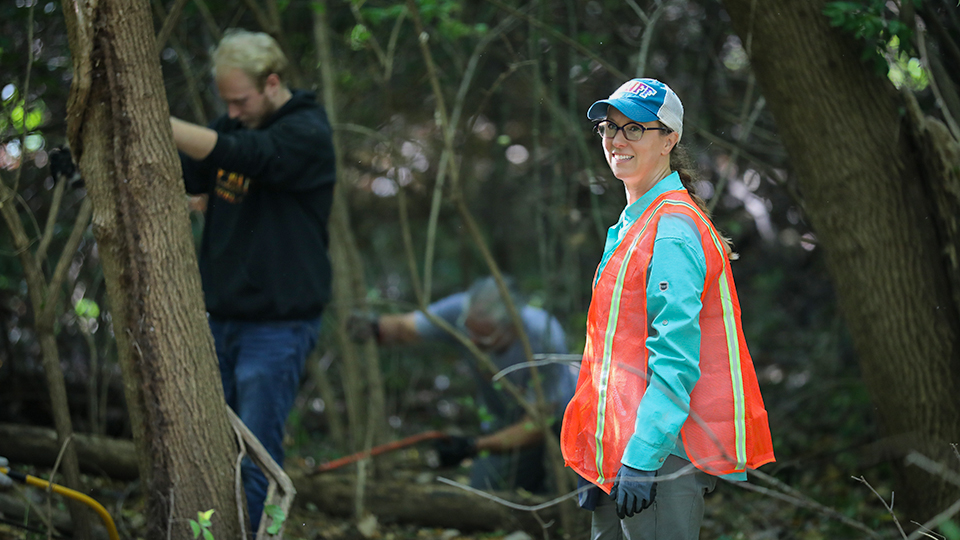September 26, 2023
JCCC Professor Tai Edwards helps keep sacred rock project rolling
JCCC’s Kansas Studies Institute (KSI) and its director, Tai Edwards, have been an integral part of a two-phase project to return Iⁿ‘zhúje‘waxóbe (translated "sacred red rock") to the Kaw Nation.
”This project is a model for how communities can engage with histories of colonization and engage directly with tribal nations,” Edwards said. “It’s an example of rematriation, where not only Iⁿ‘zhúje‘waxóbe will return to the Kaw Nation, but Kaw citizens, scholars, artists and community members work together to educate the public about Kanza history and tribal nation sovereignty.”
The sizable red rock is a 28-ton Sioux Quartzite Glacial Erratic that was pushed by glaciers in the last ice age to the Kansas River, near Tecumseh, Kansas. The rock remained there for thousands of years and was part of the Kaw Nation (also known as Kanza) sacred prayer chart.
The Kanza people were repeatedly displaced from their land by the U.S. government so settlers could own the land. This led to shrinking reservations and a final expulsion from Kansas to Oklahoma in the 1870s.
Between the sacred rock and a historical hard place
In 1929, the City of Lawrence, using a railroad crane, took Iⁿ‘zhúje‘waxóbe out of the Kansas River and placed the rock in Robinson Park, at the north end of downtown near the river bridge, with a plaque commemorating the town's founders. Even though it was documented at the time in local newspapers and other sources that Kanza people had a sacred relationship with Iⁿ‘zhúje‘waxóbe, the Kanza people were not mentioned on the rock or in the park.
In 2021, the Kaw Nation formally asked the City of Lawrence and Douglas County governments to return Iⁿ‘zhúje‘waxóbe. Lawrence and Douglas County apologized for taking Iⁿ‘zhúje‘waxóbe and agreed to an unconditional return.
Iⁿ‘zhúje‘waxóbe has now been moved out of Robinson Park and will be placed in storage while infrastructure is built in the Kaw Nation-owned Allegawaho Memorial Heritage Park near Council Grove, Kansas.
Mapping a move from Robinson Park
During phase 1 of the project, surrounding community members were educated on the research on Iⁿ‘zhúje‘waxóbe and how it ended up in Robinson Park. Edwards assisted in writing about the research and documented the project's activities.
Phase 2 included the Mellon Grant-funded Sacred Red Rock project. Edwards is co-editor, along with C. Huffman (Kaw Citizen) and Jay Johnson, of a book that will feature pieces written by the co-editors, as well as other partners and artists about the rematriation project. They are currently working with authors and writing pieces for the text. The book’s projected release date is 2025.
Past stays present in classrooms
Huffman and Edwards have also written a curriculum about the project, which Edwards has used in her JCCC history classes.
“My students have thoroughly enjoyed learning about Iⁿ‘zhúje‘waxóbe and especially hearing Kaw elder Curtis Kehkahbah explain the Kaw relationship to this sacred red rock,” Edwards said. “Students and the public are hungry for more information about indigenous histories and lives in Kansas. One of our goals on this project was to create more resources that instructors could easily use in classrooms and that students would find accessible, engaging and ultimately informative.”
As part of a statewide initiative coordinated by the Kansas State Department of Education, Edwards also conducted presentations to middle schoolers and elementary schoolers in Lawrence about Iⁿ‘zhúje‘waxóbe, and included interactive activity guides (PDF). Another research topic students covered was Charles Robinson, the state's first governor and for whom the park where Iⁿ‘zhúje‘waxóbe resided is named.
Edwards is part of a collaboration to improve American Indian education across the state of Kansas. She’s also continuing KSI’s involvement with the Quindaro Ruins Project Foundation’s preservation work.

